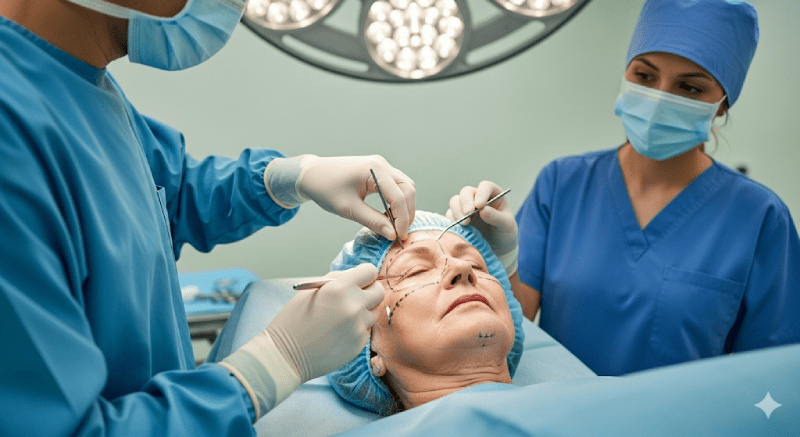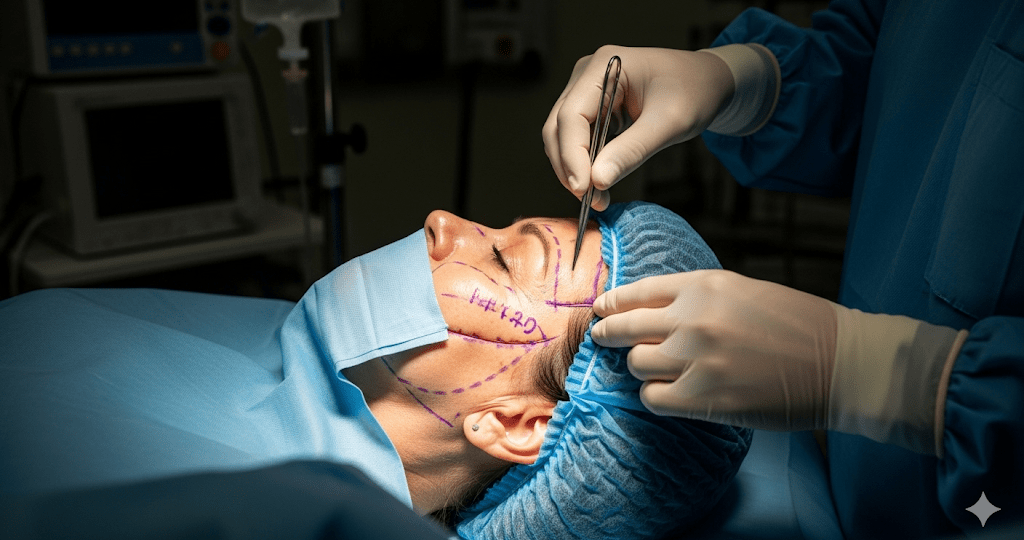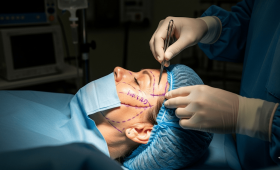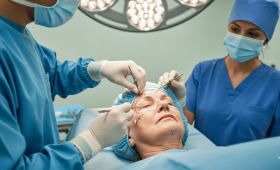What is Thread Lifting?
Thread lifting is a minimally invasive aesthetic procedure applied to provide skin rejuvenation and tightening without a surgical operation. In this method, specially designed, bio-absorbable threads are placed in the lower layers of the skin. These threads lift the skin upwards to reduce sagging and also trigger the skin’s own collagen production. In this way, the skin gains a more taut and vibrant appearance after the procedure. Thread lifting is an ideal option for those who want to rejuvenate without the risks of surgery.
What are PDO Threads?
PDO threads (Polydioxanone) are a special type of thread that has been used for many years for aesthetic and medical purposes, is biocompatible, and can be completely absorbed by the body. When these threads are placed under the skin, they create a support network and pull up the sagging tissues. Although they are broken down and disappear by the body over time, the tautness and firmness of the skin are maintained for a long time thanks to the collagen and elastin fibers that form around the threads. PDO threads are known as a safe and effective rejuvenation tool.
How is Thread Lifting Done?
The thread lifting procedure is generally performed under local anesthesia and takes approximately 30 minutes to 1 hour. First, the areas of sagging on the face and the points where the threads will be placed are determined by the physician. Then, in a sterile environment, special needles or cannulas are used to place the threads in the lower layers of the skin. After the threads are placed, the tissues are slightly pulled up to achieve the desired lifting effect. Since no incision is made during the procedure, the risk of scarring is very low.
Which Areas Can It Be Applied To?
The thread lifting procedure is highly effective for treating sagging in various areas of the face and neck. The most common areas of application include eyebrow lifting, the eye area, cheeks, jawline, double chin, and neck. It can also be used to lift the tip of the nose or narrow the nostrils. This versatile method helps to achieve a more taut and youthful look overall on the skin.
What are its Advantages Over Traditional Face Lift Surgery?
Thread lifting has many significant advantages over traditional face lift surgery. The biggest advantage is that it is not a surgical procedure. Therefore, it does not require general anesthesia, incisions, or stitches. The risks of surgery, bleeding, and infection are minimal. The recovery process is much shorter and more comfortable. Patients can usually return to their daily lives immediately after the procedure. The results provide a natural and understated appearance.
Who Is a Suitable Candidate?
The thread lifting procedure is suitable for people with mild to moderate sagging on their face who do not want to undergo a surgical operation. Individuals between the ages of 30 and 60 generally get the best results. Ideal candidates are those who have not yet lost their skin elasticity, do not have excessive sagging, and are in good general health. The procedure may not be sufficient for individuals with excessive facial sagging or who have completely lost their skin elasticity.
How Long Do the Effects of a Thread Lift Last?
The results of a thread lift procedure generally last for 1 to 2 years. While the threads are absorbed by the body within 6 to 9 months, the collagen production effect they create continues for a longer period. The life of the effect can be extended with regular maintenance sessions. The aging process and lifestyle habits (smoking, alcohol) can affect the permanence of the results.
What is the Recovery Process Like?
The recovery process of a thread lifting procedure is quite fast. Mild swelling, bruising, and tenderness may be seen after the procedure, but this condition usually subsides within a few days. Patients can usually return to their daily activities immediately after the procedure. It is important to avoid heavy exercise and massaging the face. Following your doctor’s instructions will speed up the recovery process.
Why Are the Procedure Prices More Affordable Compared to Germany?
The prices for thread lifting procedures in Turkey are much more economical compared to Western European countries like Germany. The main reasons for this situation include low labor and operating costs. Clinic rents, staff salaries, and general expenses are more affordable in Turkey. Additionally, government support for health tourism and the exchange rate advantage also bring prices down to reasonable levels.
When Are the Results Visible?
The results of a thread lifting procedure are generally noticeable immediately. An immediate tightening and firming effect on the face is seen. However, the real and permanent results appear within 1-2 months as the threads trigger the production of collagen and elastin under the skin. The skin gains a fuller, smoother, and more vibrant appearance. The final results become fully apparent after 6 months.
Is the Procedure Safe?
The thread lifting procedure is a very safe procedure when performed by a specialist and experienced physician under appropriate clinical conditions. The threads used are made of biocompatible materials that can be absorbed by the body and do not cause allergic reactions. Since no incision is made during the procedure, the risk of infection is minimal.
What Are the Side Effects of the Procedure?
The possible side effects of the procedure are generally mild and temporary. The most common ones include mild swelling, bruising, tenderness in the procedure area, and small redness at the needle entry points. In rare cases, situations such as the threads being felt on the surface or asymmetry may also occur, but these can usually be easily corrected by the doctor.
Who Is Not a Suitable Candidate?
The thread lifting procedure is not suitable for pregnant or breastfeeding women, those with bleeding disorders, those with autoimmune diseases, or those with an active skin infection in the area to be treated. Additionally, the desired results may not be achieved in individuals with excessive facial sagging and a very thin skin structure.
Can It Be Repeated?
Yes, the thread lifting procedure can be safely repeated. After the effects start to diminish in 1-2 years, it is possible to refresh the results by placing additional threads in the same areas or in new areas. Small touches made at regular intervals help to maintain the skin’s youthful appearance for many years.
What Are the Non-Surgical Face Lift Methods?
In addition to thread lifting, there are many non-surgical face lift methods. The most popular ones include radiofrequency (Thermage), focused ultrasound (HIFU – Ultherapy), and laser treatments (Fraxel). These methods provide tightening by triggering collagen production under the skin. Better results can be achieved by combining thread lifting with other methods.

What Affects the Permanence of a Thread Lift?
Many factors affect the permanence of a thread lifting procedure. These include the person’s aging rate, skin structure, genetic predisposition, lifestyle (smoking, alcohol), and the duration of sun exposure. A healthy diet, regular exercise, and a good skincare routine help to maintain the results for a longer period.
Are Clinics in Turkey Safe?
Aesthetic clinics in Turkey provide services in accordance with international standards in parallel with the developments in health tourism. Many clinics have international accreditations such as JCI (Joint Commission International). The hygiene and safety standards of the clinics are regularly audited by the Ministry of Health. This provides a safe environment for foreign patients.
What Is the Difference Between a Thread Lift and Botox?
Thread lifting and Botox are two separate aesthetic procedures used for different purposes. Botox temporarily paralyzes mimic muscles to reduce dynamic wrinkles (between the eyebrows, on the forehead, and around the eyes). Thread lifting, on the other hand, corrects sagging skin and restores skin firmness by increasing collagen production. Since these two procedures target different problems, they are often applied together to achieve a more comprehensive rejuvenation effect.
What Should Be Considered Before the Procedure?
Before the procedure, the doctor’s instructions should be followed carefully. Blood-thinning medications, painkillers (like aspirin), alcohol, and smoking should be stopped at least one week in advance. These substances can increase the risk of bruising. It is important that the face is clean and no makeup is applied before the procedure. You should inform your doctor about all your chronic illnesses and the medications you use.
What Should Be Considered After the Procedure?
In the first few days after the procedure, you should avoid rubbing and massaging your face. Heavy exercise and activities like swimming pools or saunas should be avoided for a week. Avoiding sleeping on your face and keeping your head elevated helps to reduce swelling. Additionally, moisturizers and creams recommended by the doctor should be used regularly.
How Many Sessions Does the Procedure Take?
The thread lifting procedure is usually a single-session application. However, depending on the person’s skin structure and the degree of sagging, an additional session may be needed to achieve better results. After the effects of the application diminish, it may be recommended to repeat it in 1-2 years.
How Long Does the Treatment Take in Turkey?
The length of stay for thread lifting treatment in Turkey is quite short. Since the procedure itself takes less than 1 hour, it is generally possible for patients to return within one day. However, staying for a few more days for the first check-up and follow-up can be beneficial to stay in contact with the physician and monitor the recovery process.
Why Is Doctor Selection Important?
Doctor selection is of critical importance for the success and safety of the thread lifting procedure. The physician who will perform the procedure must be experienced and specialized in this field. The right technique, the right thread selection, and the correct depth of thread placement directly affect both the aesthetic results and possible complications. It may be useful to examine the photos of the physician’s previous procedures.
Is a Thread Lift Permanent?
A thread lifting procedure does not offer results like a permanent face lift surgery. However, thanks to the collagen network that forms in the skin as the threads dissolve, the effect continues for about 1-2 years. The procedure does not completely stop the aging process; it only temporarily reverses the effects of this process. Therefore, it is recommended to repeat it regularly to maintain the permanence of the results.
What Types of Threads Are Used?
In the thread lifting procedure, PDO (Polydioxanone), PLLA (Poly-L-Lactic Acid), and PCL (Polycaprolactone) threads are generally used. PDO threads are the most common and strongly trigger collagen production. PLLA and PCL threads offer longer-lasting results and can be preferred for deeper sagging.
Is a Thread Lift Suitable for Everyone?
No, a thread lift is not suitable for every age and skin type. This procedure may be insufficient for people with advanced sagging and those who have completely lost their skin elasticity. In this case, traditional surgical face lift operations offer a more effective solution. The most suitable candidates are those who do not need a face lift surgery and have mild to moderate sagging.
What Is the Cost of the Procedure?
The cost of a thread lifting procedure in Turkey varies depending on the physician’s experience, the number of threads used, and the clinic’s quality. Generally, prices for a single procedure can vary between 500 and 2,000 Euros. Packages that include services like accommodation and transfers can also be offered for patients coming from abroad.
What Is the Difference Between a Thread Lift and a Filler?
Thread lifting and fillers are procedures that serve different aesthetic purposes. Fillers give volume to the face with substances like hyaluronic acid and fill in fine lines and wrinkles. Thread lifting, on the other hand, creates a lifting effect by pulling up sagging tissues. Since these two procedures meet different needs, they can be combined.
Does Alcohol and Smoking Affect the Procedure?
Yes, alcohol and smoking can negatively affect the recovery process and the results. Smoking reduces blood flow, slowing down tissue regeneration and increasing the risk of infection. Alcohol can thin the blood, increasing post-procedure bruising and swelling. Therefore, it is recommended to stop the use of these substances at least one week before the procedure.
Are There Foreign Language Services in Clinics in Turkey?
Yes, many aesthetic clinics in Turkey have international patient departments specially designed for foreign patients. These departments employ translators and patient coordinators who speak English, German, Arabic, and other languages to solve patients’ communication problems.
Does the Procedure Leave a Scar?
Since no incision is made in the thread lifting procedure, no permanent scar remains. Only small redness or needle marks may appear at the entry and exit points of the threads, but these usually disappear on their own within a few days. This makes the procedure a scarless alternative.
How Long Does the Procedure Take?
The thread lifting procedure is completed in 30 minutes to 1 hour, depending on the area of application and the number of threads. The short duration of the procedure allows patients to even have it done during their lunch break.
Can I Get a Massage After a Thread Lift?
In the first few weeks after the procedure, massaging the treated area should be absolutely avoided. Massaging can cause the threads to shift or lead to undesirable results. Therefore, no massage should be done until the end of the period recommended by your doctor.
Are Before and After Photos Necessary?
Yes, taking before and after photos is important for both the physician and the patient. These photos help the physician to create a correct treatment plan and also allow you to clearly see the change achieved as a result of the procedure. These photos can only be used with the patient’s consent.


